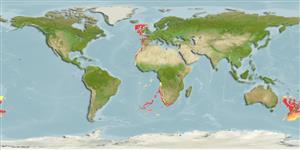Elasmobranchii (tubarões e raias) (sharks and rays) >
Squaliformes (Sleeper and dogfish sharks) >
Somniosidae (Sleeper sharks)
Etymology: Scymnodon: scymnus, an ancient name for some kind of shark, derived from a Greek word meaning young animal, cub or whelp; odon (Gr.), tooth, referring to large, triangular cutting teeth on lower jaw of S. ringens. (See ETYFish); ringens: Latin for gaping, referring to its large, open mouth (“ore amplo, hiante”). (See ETYFish).
Environment: milieu / climate zone / depth range / distribution range
Ecologia
marinhas batipelágico; intervalo de profundidade 200 - 1600 m (Ref. 247), usually 550 - 1450 m (Ref. 10717). Deep-water; 61°N - 54°S, 18°W - 172°W
Eastern Atlantic: along the slope from Scotland to Spain, Portugal, Senegal. Southwest Pacific: New Zealand (Ref. 26346).
Tamanho / Peso / Idade
Maturity: Lm ? range ? - ? cm
Max length : 110 cm TL macho/indeterminado; (Ref. 247)
Espinhos anais 0; Raios anais moles: 0. Black in color; small dorsal fin spines; short snout; small lanceolate teeth without cusplets in upper jaw and huge high, knife-cusped cutting teeth in lower jaw; mouth very wide and broadly arched; caudal fin with weak subterminal notch and no lower lobe (Ref. 247).
A rare species (Ref. 26346) inhabiting continental slopes (Ref. 247). Usually mesopelagic although taken most often near the bottom (Ref. 10717). Its razor-edged lower teeth is used to attack and dismember large prey (Ref. 247). Ovoviviparous (Ref. 205). Utilized dried salted for human consumption and for fishmeal (Ref. 247).
Life cycle and mating behavior
Maturidade | Reprodução | Desova | Ovos | Fecundidade | Larvas
Probably ovoviviparous (Ref. 247). Distinct pairing with embrace (Ref. 205).
Compagno, L.J.V., 1984. FAO Species Catalogue. Vol. 4. Sharks of the world. An annotated and illustrated catalogue of shark species known to date. Part 1 - Hexanchiformes to Lamniformes. FAO Fish. Synop. 125(4/1):1-249. Rome, FAO. (Ref. 247)
Categoria na Lista Vermelha da IUCN (Ref. 130435)
Ameaça para o homem
Traumatogenic
Utilização humana
Pescarias: pouco comercial
Mais informação
ReferênciasAquaculturaPerfil para aquaculturaEstirpesGenéticaElectrophoresesHereditariedadeDoençasProcessamentoNutrientsMass conversion
Ferramentas
Relatórios especiais
Descarregue XML
Fontes da internet
Estimates based on models
Preferred temperature (Ref.
123201): 4.2 - 11.4, mean 7.7 °C (based on 164 cells).
Phylogenetic diversity index (Ref.
82804): PD
50 = 0.7500 [Uniqueness, from 0.5 = low to 2.0 = high].
Bayesian length-weight: a=0.00389 (0.00178 - 0.00849), b=3.13 (2.94 - 3.32), in cm total length, based on LWR estimates for this species & (Sub)family-body (Ref.
93245).
Nível Trófico (Ref.
69278): 3.9 ±0.7 se; based on diet studies.
Resiliência (Ref.
120179): Baixo, tempo mínimo de duplicação da população 4,5 - 14 anos (Fec assumed to be <100).
Fishing Vulnerability (Ref.
59153): High to very high vulnerability (66 of 100).
Climate Vulnerability (Ref.
125649): Moderate to high vulnerability (46 of 100).
Nutrients (Ref.
124155): Calcium = 7.04 [1.09, 38.34] mg/100g; Iron = 0.23 [0.05, 0.90] mg/100g; Protein = 19.9 [17.3, 22.4] %; Omega3 = 0.139 [0.040, 0.507] g/100g; Selenium = 14.7 [3.5, 55.1] μg/100g; VitaminA = 28 [3, 232] μg/100g; Zinc = 0.432 [0.179, 1.137] mg/100g (wet weight);
